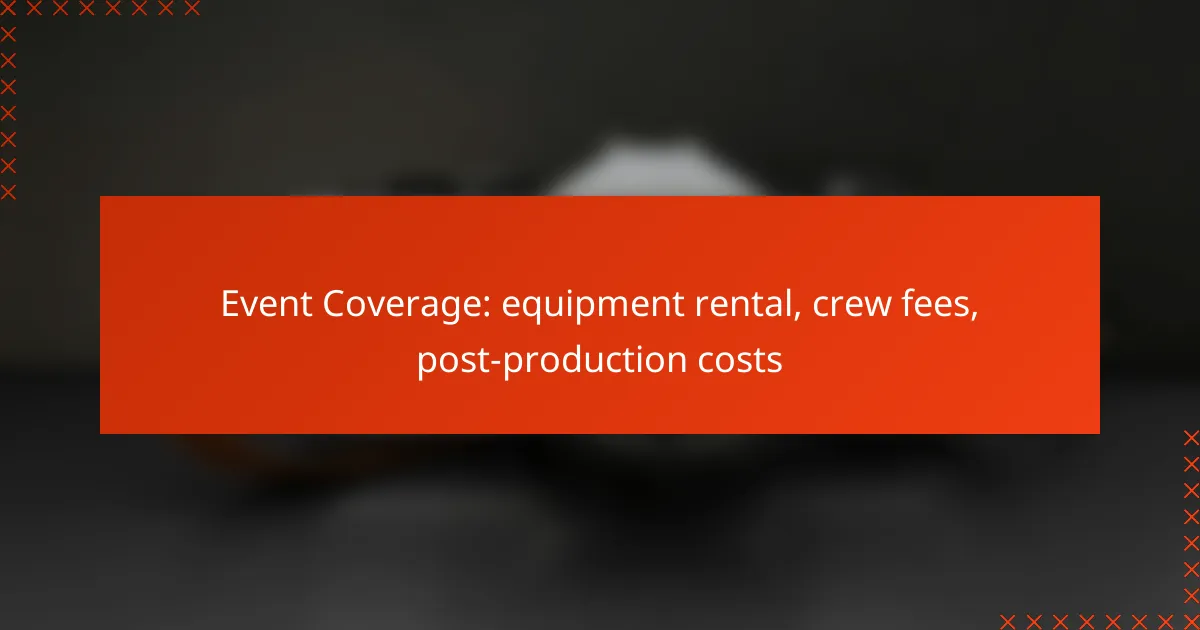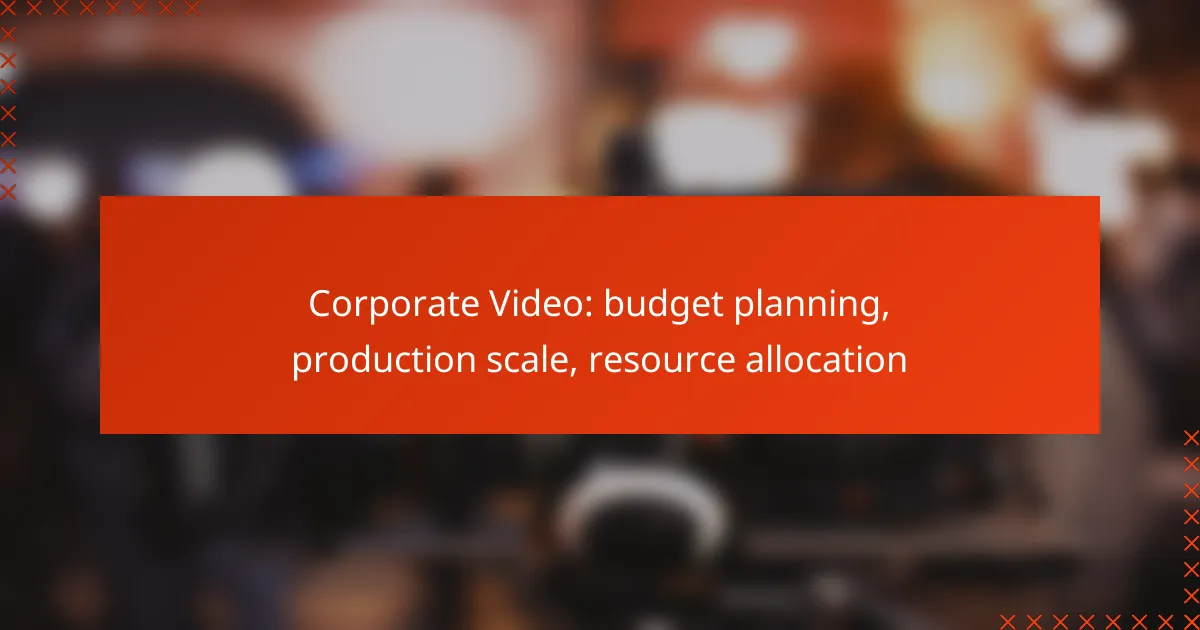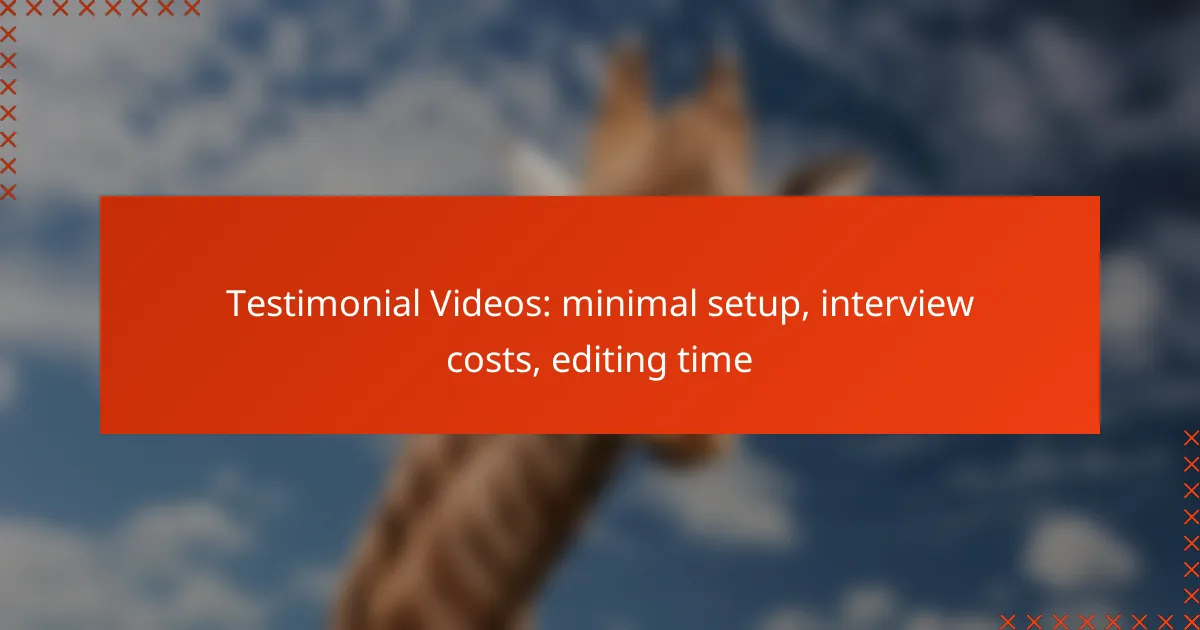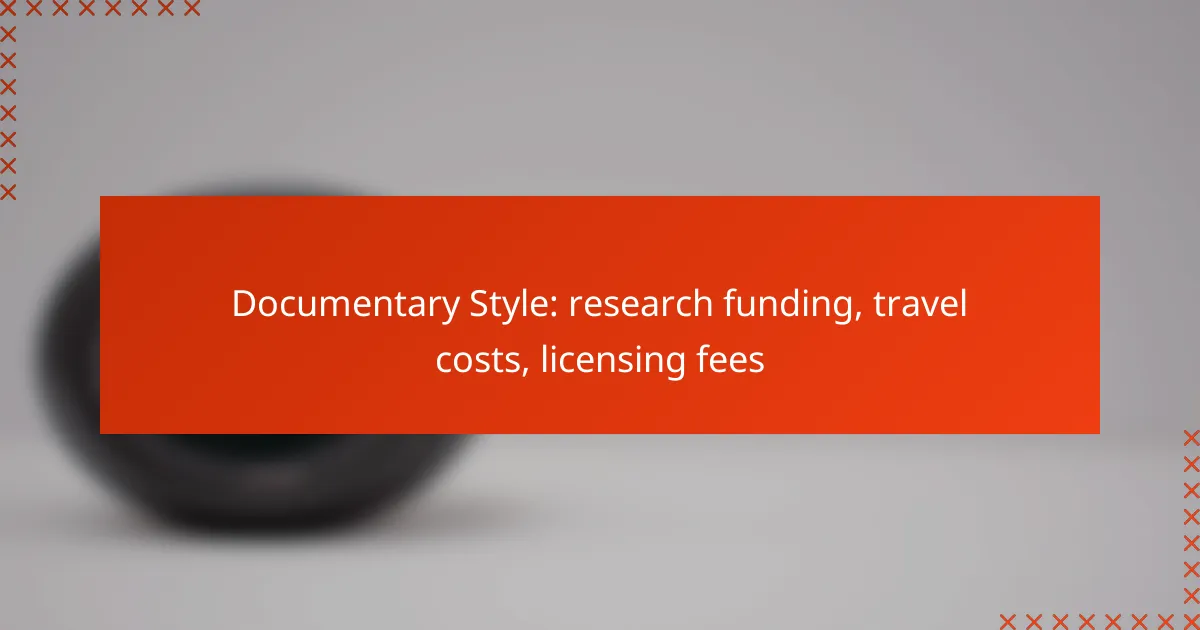When planning for event coverage in Los Angeles, it’s essential to consider various costs, including equipment rental, crew fees, and post-production expenses. These factors can significantly influence your overall budget, depending on the event type and duration. Understanding your specific needs and selecting the right equipment will help ensure a successful production while managing costs effectively.

What are the costs of event coverage in Los Angeles?
The costs of event coverage in Los Angeles can vary widely based on several factors, including the type of event, duration, and specific services required. Generally, you should budget for equipment rental, crew fees, and post-production costs to get a comprehensive understanding of the total expenses involved.
Equipment rental fees
Equipment rental fees in Los Angeles can range from a few hundred to several thousand dollars, depending on the quality and type of gear needed. Common rentals include cameras, lighting, and sound equipment. For example, a basic camera package might start around $300 per day, while high-end cinema cameras can exceed $1,500 per day.
When renting equipment, consider additional costs such as insurance and delivery fees. It’s advisable to compare rental houses and check for package deals that can reduce overall expenses.
Crew fees
Crew fees for event coverage typically range from $500 to $3,000 per day, depending on the crew’s experience and the size of the team required. A small crew for a simple event might consist of a camera operator and a sound technician, while larger productions may require directors, producers, and multiple camera operators.
Keep in mind that hiring experienced professionals can enhance the quality of your coverage, but it will also increase costs. Always clarify the scope of work and negotiate rates upfront to avoid surprises.
Post-production costs
Post-production costs in Los Angeles can vary significantly, often falling between $500 and $5,000 or more, depending on the complexity of the editing required. Basic editing might include cutting footage and adding transitions, while more advanced services could involve color grading, sound design, and visual effects.
When budgeting for post-production, consider the timeline as well; rush jobs may incur higher fees. It’s beneficial to discuss your vision with an editor early on to get a clearer estimate and avoid unexpected charges later in the process.

How to choose the right equipment for event coverage?
Selecting the right equipment for event coverage involves understanding the specific needs of your event, including the type of content you want to capture and the environment in which you’ll be working. Consider factors such as portability, ease of use, and compatibility with other gear to ensure a successful shoot.
Camera types for events
When choosing a camera for event coverage, consider options like DSLRs, mirrorless cameras, and camcorders. DSLRs and mirrorless cameras offer high image quality and versatility, while camcorders are designed for extended recording times and ease of use in dynamic environments.
For most events, a mirrorless camera is often preferred due to its lightweight design and superior autofocus capabilities. Look for models that support interchangeable lenses to adapt to various shooting conditions.
Audio equipment options
Audio quality is crucial in event coverage, so invest in good microphones. Lavalier mics are ideal for interviews and speeches, while shotgun mics work well for capturing sound from a distance. Consider using a portable audio recorder for better sound isolation.
Ensure that your audio equipment is compatible with your camera system. Using a wireless setup can enhance mobility, but be mindful of potential interference in crowded venues.
Lighting setups
Proper lighting can dramatically improve the quality of your event coverage. Consider using LED panels or softboxes for even illumination, especially in low-light environments. Portable lighting kits are also available for on-the-go setups.
When planning your lighting, assess the venue’s existing light sources and adjust your setup accordingly. Avoid harsh shadows and overexposed highlights by using diffusers or reflectors to soften the light.

What are typical crew fees for event coverage?
Typical crew fees for event coverage can vary significantly based on the type of event, location, and the experience level of the crew. Freelance videographers, editors, and production assistants each have distinct rates that contribute to the overall budget.
Freelance videographer rates
Freelance videographer rates typically range from $50 to $150 per hour, depending on their experience and the complexity of the project. For full-day events, many videographers may offer a flat rate, which can be anywhere from $500 to $2,000. It’s essential to clarify what is included in the fee, such as equipment usage and post-production services.
When hiring a videographer, consider their portfolio and reviews to ensure they match your event’s style and needs. Additionally, booking well in advance can sometimes lead to better rates.
Editor fees
Editor fees generally fall between $30 and $100 per hour, with many editors offering package rates for specific projects. For instance, a standard editing package for a 1-hour event video might cost between $300 and $800, depending on the level of editing required and the editor’s expertise.
When selecting an editor, review their previous work to gauge their editing style and efficiency. Clear communication about your vision can help avoid misunderstandings and additional costs.
Production assistant costs
Production assistants typically charge between $15 and $30 per hour. Their role is to support the crew with various tasks, which can include setting up equipment, managing logistics, and assisting during the event. For larger events, hiring one or more assistants can significantly streamline the production process.
When hiring production assistants, consider their experience level and specific skills that may benefit your event. Properly briefing them on their responsibilities can enhance overall efficiency and reduce potential issues on the day of the event.

What post-production costs should be considered?
Post-production costs encompass various expenses that arise after filming, including editing software, color grading, and sound design. Understanding these costs is essential for budgeting and ensuring a polished final product.
Editing software expenses
Editing software expenses can vary significantly based on the tools you choose. Popular options like Adobe Premiere Pro or Final Cut Pro typically require a subscription or a one-time purchase, costing anywhere from $20 to $300. Consider whether you need advanced features or if simpler software will suffice for your project.
Additionally, factor in potential add-ons or plugins that enhance functionality, which can add to your overall budget. Always weigh the benefits of investing in high-quality software against your project’s specific needs.
Color grading services
Color grading services enhance the visual appeal of your footage by adjusting colors and tones. Hiring a professional colorist can cost between $50 and $150 per hour, depending on their expertise and the complexity of your project. Alternatively, you can use software with built-in color grading tools, which may save costs but require a learning curve.
When budgeting, consider the length of your footage and the desired quality. Projects with extensive color correction may necessitate a larger budget for professional services to achieve a cinematic look.
Sound design costs
Sound design costs involve creating and mixing audio elements to enhance the viewing experience. Hiring a sound designer can range from $30 to $100 per hour, depending on their experience and the project’s requirements. Alternatively, you can use royalty-free sound libraries, which often charge a flat fee for access to a wide range of sounds.
When planning your budget, assess the importance of sound design for your project. High-quality audio can significantly impact the overall production value, so allocate funds accordingly to avoid compromising on this critical aspect.
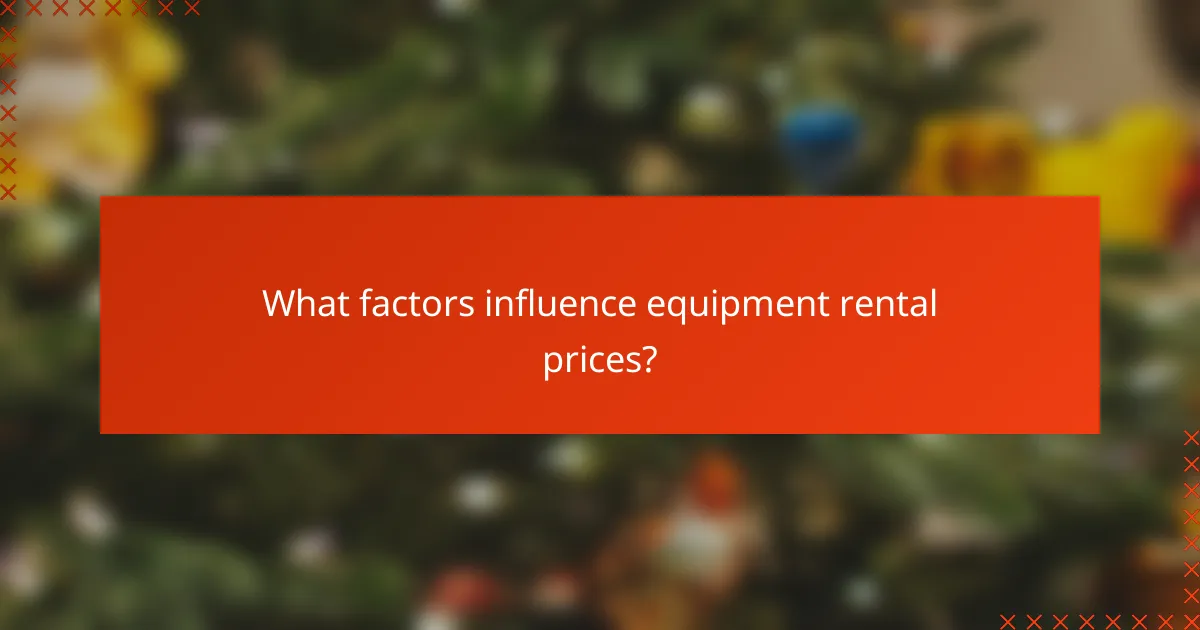
What factors influence equipment rental prices?
Equipment rental prices are influenced by several key factors, including the duration of the rental, the brand and model of the equipment, and the location of the rental service. Understanding these elements can help you make informed decisions and manage your budget effectively.
Rental duration
The length of time you need the equipment significantly impacts rental costs. Typically, rental companies offer lower daily rates for longer rental periods, such as weekly or monthly rates, compared to short-term rentals. For example, a camera might cost $100 per day, but only $600 for a week.
When planning your rental, consider how long you will actually need the equipment. If you anticipate needing it for several days, it may be more economical to rent it for a week, even if you don’t use it every day.
Equipment brand and model
The brand and model of the equipment can greatly affect rental prices, as high-end brands or specialized models often come with a premium. For instance, renting a top-tier cinema camera may cost significantly more than a standard DSLR. Be sure to evaluate your project needs against the capabilities of different models.
Additionally, newer models may have higher rental fees due to demand and availability. It’s wise to balance your budget with the specific features required for your event to avoid overspending on unnecessary equipment.
Location of rental
The geographical location of the rental service can also influence pricing. Rentals in major cities or popular event hubs may be more expensive due to higher demand and operational costs. For example, renting equipment in New York City might cost more than in a smaller town.
Consider looking for rental companies outside of high-demand areas, as they may offer more competitive rates. However, factor in any potential transportation costs to ensure you stay within budget.

How to budget for event coverage?
To budget for event coverage, identify all potential costs associated with equipment rental, crew fees, and post-production expenses. A comprehensive approach ensures you allocate sufficient funds to avoid overspending or compromising quality.
Creating a detailed budget plan
Start by listing all necessary components for your event coverage, including cameras, lighting, sound equipment, and crew members. Research rental prices for equipment, which can vary widely based on quality and location, typically ranging from hundreds to thousands of dollars.
Include crew fees in your budget, considering factors such as the number of crew members, their experience levels, and the duration of the event. Rates can range from $25 to $150 per hour, depending on the role and expertise required.
Estimating total costs
To estimate total costs, sum all equipment rental fees, crew wages, and post-production expenses, which may include editing and special effects. Post-production can add significantly to your budget, often accounting for 20-30% of total costs, depending on the complexity of the project.
Consider creating a contingency fund of around 10-15% of your total budget to cover unexpected expenses. This can help you manage any last-minute changes or additional needs that arise during the event or post-production phase.
